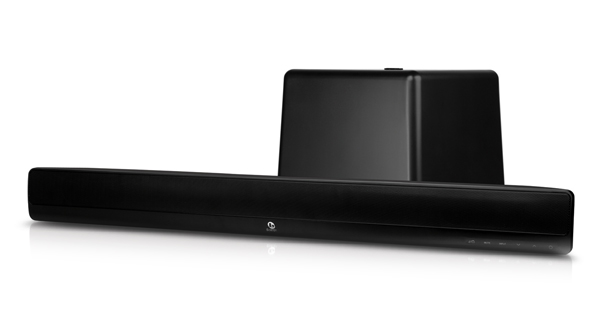
It’s tough to talk about Boston Acoustics’ sound bars without noting the ironic fact that the company introduced one of the first versions of the product in the late 90’s, only to have it flop. The product was dubbed, simply, Soundbar. The problem wasn’t product quality, just lack of demand. But since it was such a dud, the company didn’t bother to register the name. Well, hindsight is 20/20 and, with the TVee10 ($200) and TVee26 ($350), the future still looks bright for one of the sound bar’s pioneers.
We got some ears-on time with both products in a clever little demonstration where the tap-dancing penguins of Happy Feet took center stage. First, we listened to the film on the TVs built-in, down-firing speakers, and it didn’t seem to sound all that poor. Then we switched over to the Tvee10, which, of course, represented a very notable step up. But the real trick was switching back to the TVs audio again, which now sounded like it was trapped inside a tin box. It felt recessed, as if it were sequestered within the television. It created the bizarre but persistent urge to stick one’s head into TV-land to get closer to the source of the sound. The difference isn’t surprising when you consider that both of Boston Acoustics’ sound bars break down the entire source audio signature and replace it using their own technology. The result is that the quartet of drivers (two 2-inch and two 5-inch) produce audio that seems to be emanating from all around you, rather than from directly in front of you.
The big difference between the TVee26 and the Tvee10 comes with respect to low frequency output. Big bass – the kind that will cause percussive sounds to thump in your chest – is not the TVee10’s strong-suit. Its frequency response is rated at 70Hz-20KHz, meaning the lowest of the lows aren’t covered. The TVee26, on the other hand – with it’s accompanying sub-woofer and 40Hz-20KHz response – specializes in digging down to bring the theater-like boom. Though the addition of the sub is essentially the only difference between the 26 and 10, if you’re about powerful, big sound, you may want to go with the more expensive model.
Also of note, is that both models sport three inputs (one optical, two analog) and feature face-mounted buttons that light up at a touch, but go dark after a few seconds of inactivity; those of us with distractable eyes are grateful. Neither features Bluetooth technology.
We left impressed with both soundbars, and it seems clear that both will appeal to a distinct customer niche. If you’re looking for a solid, immersive, lower-cost step-up in sound, go with the TVee10. If you’re looking for a sizeable, pect-thumping audio option, go with the Tvee26. Both are available now.


